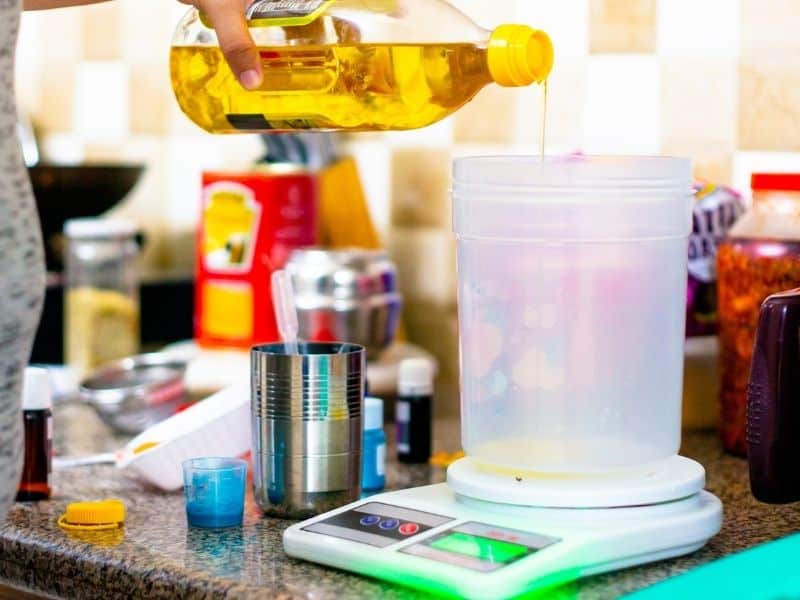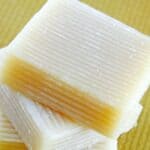Flashpoint is another one of those words that you need to learn when you begin making soap or learning to make candles. It is sort of safety-related but it also has a lot to do with the quality of your product. What does flashpoint mean in soap making?
The flashpoint of an oil in soap making is the lowest temperature at which the oil will give off sufficient vapor to ignite in air. In other words, it’s the point at which the oil becomes flammable.
For example, if you have a bottle of essential oil and you hold a lighter up to it, the oil will start to burn. The flashpoint of that oil is the temperature at which it starts to burn.
A lot of oil is used to make soap so this seems like it might be important. Let’s take a closer look at what this means for soap makers.
Soap Making Oils and Their Flashpoints
Multiple types of oil are used when making soap. The oils or fats that are used in the saponification process, fragrance oils that give the soap its scent, or essential oils that add scent and other properties. Each one of these has its own flashpoint.
Fragrance Oil Flashpoints
You will find a lot of fragrance oils with flashpoints between 145 F and 185 F, with a few slightly below and above. While flashpoints do present a safety issue the thing that is important for most of us is that the flashpoint is when the fragrance oil begins to evaporate.
When the oil begins to evaporate you are losing fragrance from your recipe. So whatever amount of oil you were required to use in the recipe is being reduced constantly as it remains at or above its flashpoint.
Essential Oil Flashpoints
Essential oil flashpoints work the same as fragrance oil flashpoints, but you will find essential oils are much more potent and have flashpoints that are a lot lower.
While you can still have flashpoints that are up around 200 F, many essential oil flashpoints are between 100 F and 140 F.
This means that essential oils will become flammable much sooner, and you will be losing your fragrance to evaporation much sooner.
Soap Making Oil Flashpoints
The other oils that you use in soap making generally have flashpoints that are much higher. These flashpoints can range from 300 F to 425 F.
So the flashpoints of these oils used for making soap are less of a problem and not something that you really need to worry about.
Importance of Flashpoints in Soap Making
The flashpoint of a substance is important to know when you are making soap. The lower the flashpoint, the more quickly the oil will start to evaporate and lose its fragrance.
When you are working with a fragrance oil that has a flashpoint of 145 F, for example, you need to keep in mind that as soon as that oil reaches 145 F it starts to lose its fragrance.
With a flashpoint of 185 F, the oil will start to lose its fragrance at that temperature but it will take longer for the majority of the oil to evaporate.
While you don’t need to know the flashpoints of every oil that you use in soap making, it is important to be aware of the flashpoints of the oils that you are using for fragrance.
Knowing the flashpoint of an oil will help you to create a recipe that will have a longer-lasting fragrance.
Finding Fragrance Oil Flashpoints
The flashpoint of whatever oil you are using should be clearly printed on the bottle, and if it is not you should contact the retailer or the manufacturer.
If you are looking for flashpoint information on fragrance oils, there are a few places that you can find it.
One is the International Fragrance Association (IFRA). They have a list of fragrance oils and their flashpoints.
Another is the Perfumers Guild. They also have a list of flashpoints for fragrance oils.
You can also find flashpoint information on the internet. Just do a search for “fragrance oil flashpoints” and you will find a number of websites that list the flashpoints for various oils.
Avoiding Flashpoint Safety Hazards
Always keep in mind that the flashpoint is the temperature at which oil becomes flammable. The oil should be handled with care when working around heat sources.
If you are using a hotplate, stovetop or oven to heat your soapmaking oils, be sure to keep an eye on the flashpoint of the oil.
If you are using a crockpot or slow cooker, be aware that the temperature can rise over the flashpoint of some oils.
When working with any type of heat source, it is important to take precautions to avoid any type of fire.
Just because an oil has a flashpoint that is above the temperature of the heat source you are using, it does not mean that it is safe to use.
It is always better to be safe than sorry, so take precautions when working with any type of heat source.
Soap making can be a fun and rewarding hobby, but it is important to be aware of the flashpoints of the oils that you are using.
Frequently Asked Questions
The flashpoint of a substance is the temperature at which it becomes flammable.
The lower the flashpoint, the more quickly the oil will start to evaporate and lose its fragrance. Knowing the flashpoint of an oil will help you to create a recipe that will have a longer-lasting fragrance.
Some essential oils have flashpoints that are much lower than other oils. Oils with flashpoints of less than 100 F include: lemongrass, orange, lavender, grapefruit, and peppermint.
Always keep in mind that the flashpoint is the temperature at which oil becomes flammable. The oil should be handled with care when working around heat sources. If you are using a hotplate, stovetop or oven to heat your soapmaking oils, be sure to keep an eye on the flashpoint of the oil.
The flashpoint of whatever oil you are using should be clearly printed on the bottle, and if it is not you should contact the retailer or the manufacturer. If you are looking for flashpoint information on fragrance oils, there are a few places that you can find it. One is the International Fragrance Association (IFRA).
Conclusion
In conclusion, it is important to be aware of the flashpoint of the oils that you are using for fragrance in your soapmaking. The flashpoint is the temperature at which oil becomes flammable, so it is important to take precautions when working with any type of heat source. Knowing the flashpoint of an oil will help you to create a recipe that will have a longer-lasting fragrance.






